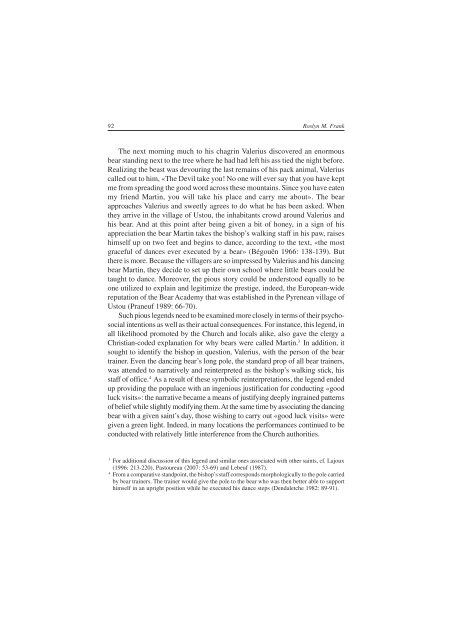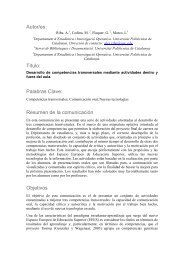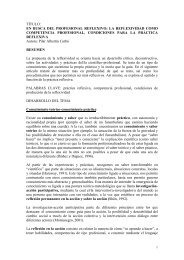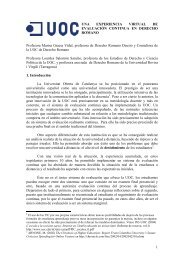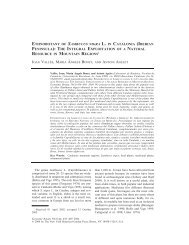Impaginato 5.p65 - Universitat Rovira i Virgili
Impaginato 5.p65 - Universitat Rovira i Virgili
Impaginato 5.p65 - Universitat Rovira i Virgili
Create successful ePaper yourself
Turn your PDF publications into a flip-book with our unique Google optimized e-Paper software.
92<br />
Roslyn M. Frank<br />
The next morning much to his chagrin Valerius discovered an enormous<br />
bear standing next to the tree where he had had left his ass tied the night before.<br />
Realizing the beast was devouring the last remains of his pack animal, Valerius<br />
called out to him, «The Devil take you! No one will ever say that you have kept<br />
me from spreading the good word across these mountains. Since you have eaten<br />
my friend Martin, you will take his place and carry me about». The bear<br />
approaches Valerius and sweetly agrees to do what he has been asked. When<br />
they arrive in the village of Ustou, the inhabitants crowd around Valerius and<br />
his bear. And at this point after being given a bit of honey, in a sign of his<br />
appreciation the bear Martin takes the bishop’s walking staff in his paw, raises<br />
himself up on two feet and begins to dance, according to the text, «the most<br />
graceful of dances ever executed by a bear» (Bégouën 1966: 138-139). But<br />
there is more. Because the villagers are so impressed by Valerius and his dancing<br />
bear Martin, they decide to set up their own school where little bears could be<br />
taught to dance. Moreover, the pious story could be understood equally to be<br />
one utilized to explain and legitimize the prestige, indeed, the European-wide<br />
reputation of the Bear Academy that was established in the Pyrenean village of<br />
Ustou (Praneuf 1989: 66-70).<br />
Such pious legends need to be examined more closely in terms of their psychosocial<br />
intentions as well as their actual consequences. For instance, this legend, in<br />
all likelihood promoted by the Church and locals alike, also gave the clergy a<br />
Christian-coded explanation for why bears were called Martin. 3 In addition, it<br />
sought to identify the bishop in question, Valerius, with the person of the bear<br />
trainer. Even the dancing bear’s long pole, the standard prop of all bear trainers,<br />
was attended to narratively and reinterpreted as the bishop’s walking stick, his<br />
staff of office. 4 As a result of these symbolic reinterpretations, the legend ended<br />
up providing the populace with an ingenious justification for conducting «good<br />
luck visits»: the narrative became a means of justifying deeply ingrained patterns<br />
of belief while slightly modifying them. At the same time by associating the dancing<br />
bear with a given saint’s day, those wishing to carry out «good luck visits» were<br />
given a green light. Indeed, in many locations the performances continued to be<br />
conducted with relatively little interference from the Church authorities.<br />
3 For additional discussion of this legend and similar ones associated with other saints, cf. Lajoux<br />
(1996: 213-220), Pastoureau (2007: 53-69) and Lebeuf (1987).<br />
4 From a comparative standpoint, the bishop’s staff corresponds morphologically to the pole carried<br />
by bear trainers. The trainer would give the pole to the bear who was then better able to support<br />
himself in an upright position while he executed his dance steps (Dendaletche 1982: 89-91).


